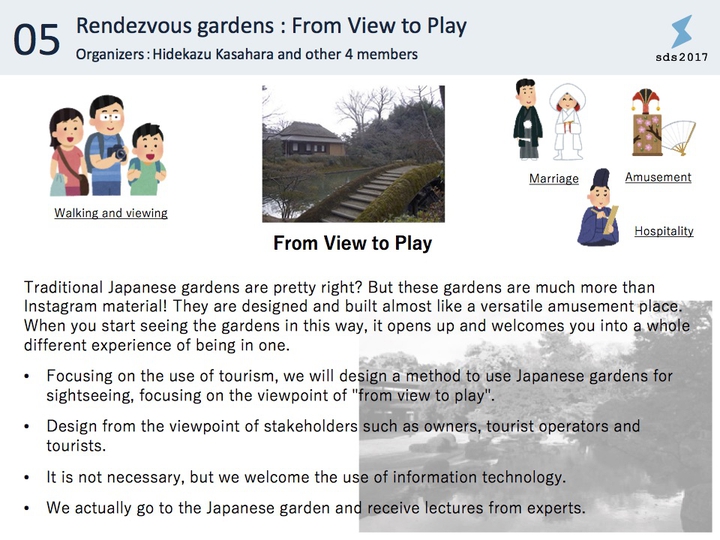Traditional japanese gardens are pretty right? But these gardens are much more than instagram material! They are designed and built almost like a versatile amusement place. When you start seeing the gardens in this way, it opens up and welcomes you into a whole different experience of being in one.
| Name | Organization | Specialty |
|---|---|---|
| Hidekazu Kasahara | Kyoto University, ACCM | Tourism informatics |
| Yoshiko Kano | Writer, Vocalist | Garden |
| Sayuri Saito | Niwa Bunka Lab. | Fine Art |
| Kozo Yamada | Hanatoyo Garden. Inc. | Gardening |
| Kaori Machida | Kyoto University of Art and Design | Japan garden history |
From Shinsenen Garden built in the Heian dynasty era to Katsura Rikyu Palace and Murin-an Villa built in Edo / Meiji modern era, we can find too many Japanese gardens in Kyoto. The styles cover wide varieties such as Chisen (pond stroll style), Roji(Tea garden style), Kaiyu (Circuit style), and they were built in various ages from Heian dynasty era, middle era to modern era. However, the usage of Japanese gardens in recent days is limited to “Viewing” and most of people are not familiar with using Japanese gardens in daily lives. Most of us have only visited to Japanese gardens in school excursions. However, the gardens had been used as a filed for various purposes. For examples, some empirical researchs report that Daimyo lord or high officials in Bakuhu administration used the garden for “amusement” purposes such as reception or enterteinment in Edo era. Also, the gardens are exotic for foreign tourists, and the gardens are sometimes used for wedding ceremony with foreign couples. Such way of existance as ambiguous field should be re-evaluated.
In this theme, This theme focuses on the use of tourism, and designs methods to use Japanese gardens for sightseeing on the axis of "amusing from viewing". Specifically, we propose a method of utilizing gardens that are accepted by the garden owners, tourism industry and tourists. It is not essential, but we welcome the use of information technology.
The main goal of this theme is to become conscious of the improvement of tourism resources such as the Japanese gardens that have been viewed from ancient times. Know how to share the awareness and problems gained through on-the-spot observations and interviews, and to form a proposal to be accepted by stakeholders through prototyping services. In the use of cultural properties, there are two different vectors of tourism and preservation, and the viewpoint of cooperation between them is an important factor in design.
- Service design considering with various stakeholders
[Design Method]
- Field Work / Interview
- Brain storming
- Prototyping
- Move to Seifu-Soh garden in Kyoto Univ.
- Lrpport, self introduction
Seifu-so
- Background presentation by professionals including Q&A
- Observarion and analysis
Seifu-so
- Share the observations amond members and extract issues
- (if possible) Return to KRP
KRP
- Review
- Idea generation
KRP
- Idea selection
- Service prototyping
- Preparation (KRP)
- Presentation (KRP)
